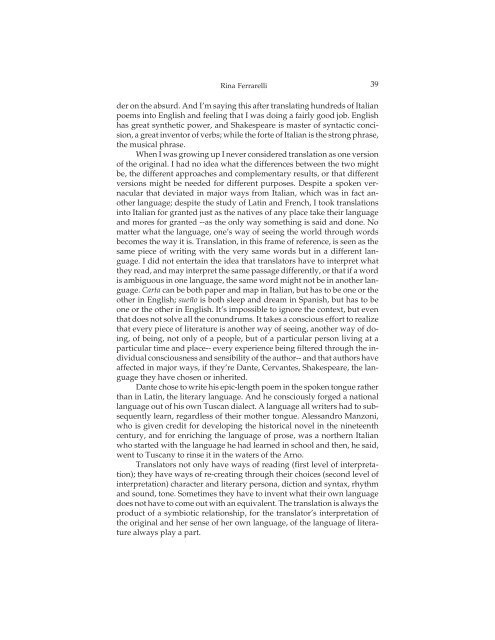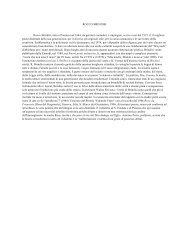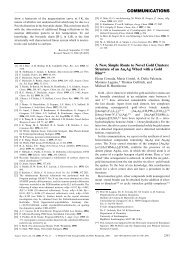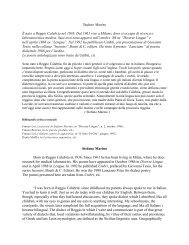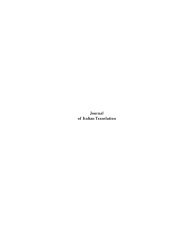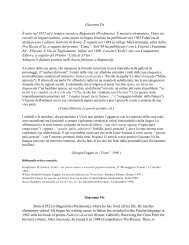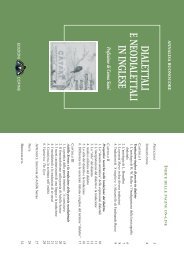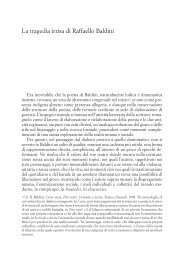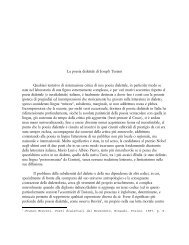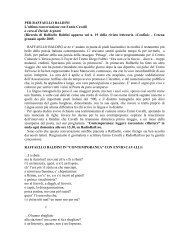Journal of Italian Translation
Journal of Italian Translation
Journal of Italian Translation
Create successful ePaper yourself
Turn your PDF publications into a flip-book with our unique Google optimized e-Paper software.
Rina Ferrarelli<br />
der on the absurd. And I’m saying this after translating hundreds <strong>of</strong> <strong>Italian</strong><br />
poems into English and feeling that I was doing a fairly good job. English<br />
has great synthetic power, and Shakespeare is master <strong>of</strong> syntactic concision,<br />
a great inventor <strong>of</strong> verbs; while the forte <strong>of</strong> <strong>Italian</strong> is the strong phrase,<br />
the musical phrase.<br />
When I was growing up I never considered translation as one version<br />
<strong>of</strong> the original. I had no idea what the differences between the two might<br />
be, the different approaches and complementary results, or that different<br />
versions might be needed for different purposes. Despite a spoken vernacular<br />
that deviated in major ways from <strong>Italian</strong>, which was in fact another<br />
language; despite the study <strong>of</strong> Latin and French, I took translations<br />
into <strong>Italian</strong> for granted just as the natives <strong>of</strong> any place take their language<br />
and mores for granted --as the only way something is said and done. No<br />
matter what the language, one’s way <strong>of</strong> seeing the world through words<br />
becomes the way it is. <strong>Translation</strong>, in this frame <strong>of</strong> reference, is seen as the<br />
same piece <strong>of</strong> writing with the very same words but in a different language.<br />
I did not entertain the idea that translators have to interpret what<br />
they read, and may interpret the same passage differently, or that if a word<br />
is ambiguous in one language, the same word might not be in another language.<br />
Carta can be both paper and map in <strong>Italian</strong>, but has to be one or the<br />
other in English; sueño is both sleep and dream in Spanish, but has to be<br />
one or the other in English. It’s impossible to ignore the context, but even<br />
that does not solve all the conundrums. It takes a conscious effort to realize<br />
that every piece <strong>of</strong> literature is another way <strong>of</strong> seeing, another way <strong>of</strong> doing,<br />
<strong>of</strong> being, not only <strong>of</strong> a people, but <strong>of</strong> a particular person living at a<br />
particular time and place-- every experience being filtered through the individual<br />
consciousness and sensibility <strong>of</strong> the author-- and that authors have<br />
affected in major ways, if they’re Dante, Cervantes, Shakespeare, the language<br />
they have chosen or inherited.<br />
Dante chose to write his epic-length poem in the spoken tongue rather<br />
than in Latin, the literary language. And he consciously forged a national<br />
language out <strong>of</strong> his own Tuscan dialect. A language all writers had to subsequently<br />
learn, regardless <strong>of</strong> their mother tongue. Alessandro Manzoni,<br />
who is given credit for developing the historical novel in the nineteenth<br />
century, and for enriching the language <strong>of</strong> prose, was a northern <strong>Italian</strong><br />
who started with the language he had learned in school and then, he said,<br />
went to Tuscany to rinse it in the waters <strong>of</strong> the Arno.<br />
Translators not only have ways <strong>of</strong> reading (first level <strong>of</strong> interpretation);<br />
they have ways <strong>of</strong> re-creating through their choices (second level <strong>of</strong><br />
interpretation) character and literary persona, diction and syntax, rhythm<br />
and sound, tone. Sometimes they have to invent what their own language<br />
does not have to come out with an equivalent. The translation is always the<br />
product <strong>of</strong> a symbiotic relationship, for the translator’s interpretation <strong>of</strong><br />
the original and her sense <strong>of</strong> her own language, <strong>of</strong> the language <strong>of</strong> literature<br />
always play a part.<br />
39


